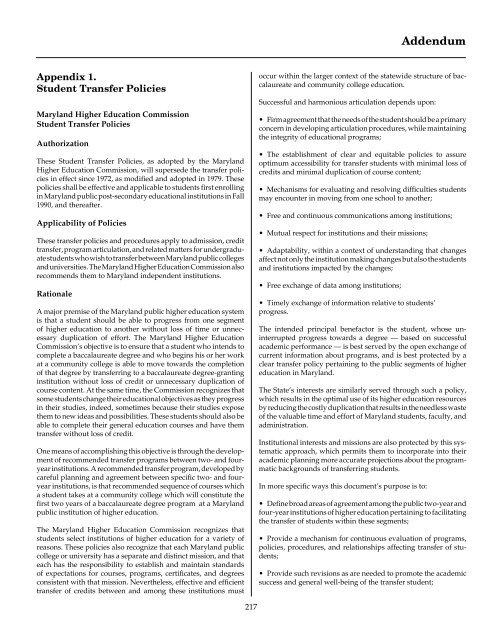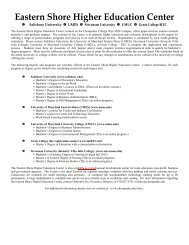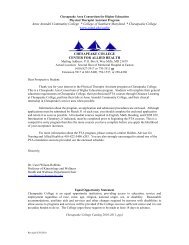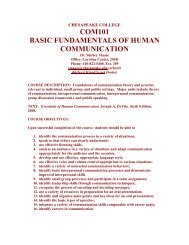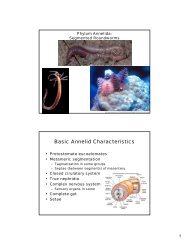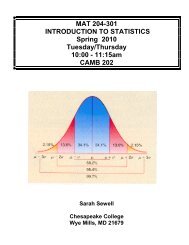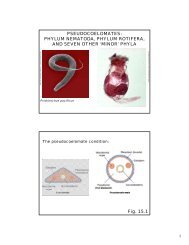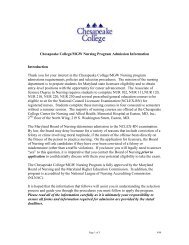Academic Calendar 2011-2012 - Chesapeake College
Academic Calendar 2011-2012 - Chesapeake College
Academic Calendar 2011-2012 - Chesapeake College
Create successful ePaper yourself
Turn your PDF publications into a flip-book with our unique Google optimized e-Paper software.
AddendumAppendix 1.Student Transfer PoliciesMaryland Higher Education CommissionStudent Transfer PoliciesAuthorizationThese Student Transfer Policies, as adopted by the MarylandHigher Education Commission, will supersede the transfer policiesin effect since 1972, as modified and adopted in 1979. Thesepolicies shall be effective and applicable to students first enrollingin Maryland public post-secondary educational institutions in Fall1990, and thereafter.Applicability of PoliciesThese transfer policies and procedures apply to admission, credittransfer, program articulation, and related matters for undergraduatestudents who wish to transfer between Maryland public collegesand universities. The Maryland Higher Education Commission alsorecommends them to Maryland independent institutions.RationaleA major premise of the Maryland public higher education systemis that a student should be able to progress from one segmentof higher education to another without loss of time or unnecessaryduplication of effort. The Maryland Higher EducationCommission’s objective is to ensure that a student who intends tocomplete a baccalaureate degree and who begins his or her workat a community college is able to move towards the completionof that degree by transferring to a baccalaureate degree-grantinginstitution without loss of credit or unnecessary duplication ofcourse content. At the same time, the Commission recognizes thatsome students change their educational objectives as they progressin their studies, indeed, sometimes because their studies exposethem to new ideas and possibilities. These students should also beable to complete their general education courses and have themtransfer without loss of credit.One means of accomplishing this objective is through the developmentof recommended transfer programs between two- and fouryearinstitutions. A recommended transfer program, developed bycareful planning and agreement between specific two- and fouryearinstitutions, is that recommended sequence of courses whicha student takes at a community college which will constitute thefirst two years of a baccalaureate degree program at a Marylandpublic institution of higher education.The Maryland Higher Education Commission recognizes thatstudents select institutions of higher education for a variety ofreasons. These policies also recognize that each Maryland publiccollege or university has a separate and distinct mission, and thateach has the responsibility to establish and maintain standardsof expectations for courses, programs, certificates, and degreesconsistent with that mission. Nevertheless, effective and efficienttransfer of credits between and among these institutions mustoccur within the larger context of the statewide structure of baccalaureateand community college education.Successful and harmonious articulation depends upon:• Firm agreement that the needs of the student should be a primaryconcern in developing articulation procedures, while maintainingthe integrity of educational programs;• The establishment of clear and equitable policies to assureoptimum accessibility for transfer students with minimal loss ofcredits and minimal duplication of course content;• Mechanisms for evaluating and resolving difficulties studentsmay encounter in moving from one school to another;• Free and continuous communications among institutions;• Mutual respect for institutions and their missions;• Adaptability, within a context of understanding that changesaffect not only the institution making changes but also the studentsand institutions impacted by the changes;• Free exchange of data among institutions;• Timely exchange of information relative to students’progress.The intended principal benefactor is the student, whose uninterruptedprogress towards a degree — based on successfulacademic performance — is best served by the open exchange ofcurrent information about programs, and is best protected by aclear transfer policy pertaining to the public segments of highereducation in Maryland.The State’s interests are similarly served through such a policy,which results in the optimal use of its higher education resourcesby reducing the costly duplication that results in the needless wasteof the valuable time and effort of Maryland students, faculty, andadministration.Institutional interests and missions are also protected by this systematicapproach, which permits them to incorporate into theiracademic planning more accurate projections about the programmaticbackgrounds of transferring students.In more specific ways this document’s purpose is to:• Define broad areas of agreement among the public two-year andfour-year institutions of higher education pertaining to facilitatingthe transfer of students within these segments;• Provide a mechanism for continuous evaluation of programs,policies, procedures, and relationships affecting transfer of students;• Provide such revisions as are needed to promote the academicsuccess and general well-being of the transfer student;217


